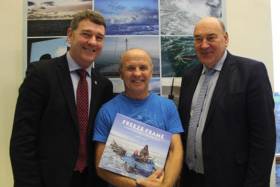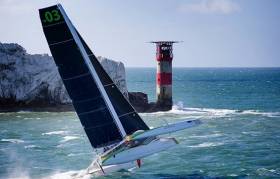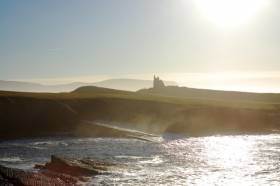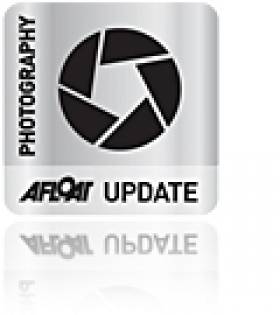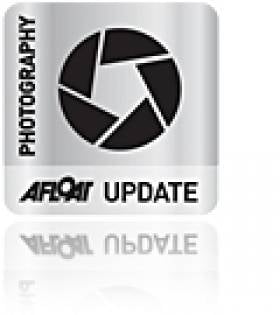Displaying items by tag: Marine Photography
Marine Institute Hosts Man Behind ‘Blue Planet’ Camera
#DougAllan - Multiple Emmy and BAFTA award-winning wildlife cameraman and photographer Doug Allan visited the Marine Institute on Wednesday (16 November) to share his remarkable insight and deep understanding of marine mammals.
Having qualified as a marine biologist, Allan now specialises in capturing spectacular footage of animals in the Arctic and Antarctic.
Spending the last 25 years bringing the most remarkable sights in the natural world into our homes, Allan has been involved in over 60 films and series such as Blue Planet, Frozen Planet and Planet Earth — the sequel to which recently began on BBC television.
To use the words of Sir David Attenborough: "Cameramen don't come more special than Doug Allan."
Allan’s awards include eight Emmys and four BAFTAs; he has twice won the underwater category in the Wildlife Photographer of the Year competition; and was awarded the Royal Geographical Society's Cherry Kearton Medal for his wildlife images. He has three Honorary Doctorates, as well as two Polar Medals.
His footage of orcas attacking grey whales, polar bears trying to capture beluga whales, and leopard seals snatching emperor penguins were the first of its kind. He has been a pioneer in both Arctic filming as well as research and has an extensive list of fascinating stories and insights.
Allan treated his audience at the Marine Institute to inspirational stories from his polar and underwater film-making career alongside some of his breath-taking images and photographs.
He told tales of how he survived encounters with polar bears, walruses and minus 40 degree temperatures to capture images of the planet's most majestic animals, above and below the ice.
Allan’s visit capped off a 17-date tour of the island of Ireland with his new show ‘In the Company of Giants’.
Phaedo3 Shot Gets Irish-Born Photographer On The List For Yacht Racing Image Prize
#Mirabaud - Irish-born marine photographer Rachel Fallon-Langdon has made the list of nominees for the 2016 Mirabaud Yacht Racing Image of the Year Award.
Rachel’s submission is a majestic shot of Phaedo3 as the MOD70 trimaran titled in the wind while rounding the Needles Lighthouse in the Round the Island Race, shattering the competition’s multihull record in the process.
That was nothing new for Phaedo3 nor for Rachel, who submitted an image of the same boat as it completed its third world sailing record within the span of a week in the 2015 contest.
The top 20 images for this year are currently on display at World Sailing’s Annual Conference in Barcelona till next Sunday 13 November, with voting for the public prize open on Facebook till Friday 18 November.
The winners in three categories will be announced during the Yacht Racing Forum in Malta on Monday 29 November.
Last year Brian Carlin, onboard reported with Team Vestas Wind during the 2014-15 Volvo Ocean Race, placed second in the public vote for his shot of the team’s heartbreaking grounding in the Indian Ocean just weeks into the race.
Mullaghmore Surfing Photo In The Running For Big Wave Award
#Surfing - A stunning photograph of Cornish surfer Tom Butler riding the swell at Mullaghmore Head was up for a top prize at the Nomad Big Wave Awards in Los Angeles this week.
The image of Butler – no stranger to Ireland's big wave scene – beneath a cresting wave netted a 'Best Shot of a Surfer in a Barrel' nomination for Irish-based South African photographer Ian Mitchinson at the inaugural awards, as the Cornish Guardian reports.
But Butler was "stoked" enough to see his spectacular shot make the front page of Monday's Irish Times, which reports on another big nomination for the Sligo swell as South African surfer Frank Solomon's attempt, filmed by Irish man Peter Clyne, is up for the 'Ride of the Year' gong.
The full list of award winners will be announced later today.
Bird's Eye Views Of Ireland's Beauty From Lough Eske To Dublin Bay
#Drones - Filmmakers have been using consumer-grade drones to capture some stunning footage in recent times, and this incredible video of Lough Eske is no exception.
Spanish video company eldrone.es launched from the grounds of Solis Lough Eske Hotel in Donegal to capture the breathtaking beauty of the lake in glorious 4K quality.
Meanwhile, Irish Rail released a similarly sweeping aerial view of the recently refurbished Drogheda Viaduct, after €6.1 million of EU-funded works that saw the installation of a new drainage system, waterproofing and state-of-the-art lighting.
It's a fitting facelift for Sir John MacNeill's engineering marvel that has spanned the River Boyne for 160 years.
Aerial photographer Dennis Horgan may not use a drone for his vistas, opting for helicopters and fixed-wing aircraft to get in position for the right shot, but his latest images captured over Dublin Bay are all the more impressive for it.
Indeed, a number of Dublin's waterfront landmarks appear in TheJournal.ie's gallery of his bird's eye view of the capital, many seen from unusual angles.
Second Place For Carlin In Yacht Racing Image Awards
#VOR - Brian Carlin's shot of Team Vestas Wind's heartbreaking grounding in the Indian Ocean a year ago has been voted by the public into second place in the Mirabaud Yacht Racing Image of the Year Award.
Carlin – who served as Team Vestas Wind's onboard reporter during the 2014-15 Volvo Ocean Race, including the team's triumphant return to the race for its final stages after months of repairs – came just behind Rick Tomlinson's aerial photo of Team Brunel cutting through the choppy seas around Cape Horn.
But the experienced marine photographer and filmmaker, whose shots have graced Afloat.ie many a time over the years, also also received the special judges' award for this year's Most Iconic Image.
We're sure few will have any quibble with that!
New Photographic Book Celebrates The Burren & Cliffs Of Moher
#Burren - The unique landscape of the Burren and the Cliffs of Moher on Ireland's Wild Atlantic Way is the subject of a new book by one of Ireland's leading photographers.
This Is The Burren, Carsten Krieger's photographic ode to the world-famous region, will be launched by Rose Hynes, a native of North Clare and chairperson of Shannon Group plc, in Hyland's Burren Hotel in Lisdoonvarna, Co Clare, this Sunday 29 November.
The Burren and the Cliffs of Moher – which, along with Waterford's Copper Coast, was last week designated with UNESCO Global Geopark status, as the Irish Examiner reports – is among Ireland’s most enigmatic and magical landscapes.
The 176 photographs featured in This Is The Burren – some of which are featured on Krieger's website HERE – capture the essence of the Burren, including its weathered karst landscape, the ever-changing light; the exotic flora; the elusive wildlife; the tombs, cairns, forts and churches; and the people who call the Burren their home.
Carsten Krieger, who was born in Germany, visited the Burren after learning it was the inspiration for JRR Tolkien’s Middle Earth. More visits followed before he and his wife finally decided to move to Co Clare to be close to the unique landscape.
After publishing his first book, Carsten moved on to other projects, but said: "The Burren always stayed close to my heart and in all the books I have made over the past decade the Burren pops up in each of them in one way or another."
Carsten returned to the Burren to take more photographs in 2011, a project that turned into his latest book.
"Although four years sounds like a long time I could easily have spent another couple of years exploring and photographing the Burren, and most likely will do so. Every trip brings something used and unexpected and a reason to return another time," he said.
Cllr James Breen, Cathaoirleach of Clare County Council, described the book as "a valuable photographic record of one of the jewels in the Irish tourism crown."
He added: "Carsten's photographs illustrate perfectly how remarkable the landscape of the Burren really is and why the work of organisations such as the Burren and Cliffs of Moher UNESCO Geopark in heritage management and sustainable development throughout the region is critical.
"The book also is a tribute to how man and nature are deeply entwined in the Burren and have shaped each other over the millennia."
Carol Gleeson, project manager for the Burren and Cliffs of Moher UNESCO Global Geopark, said her and her team were "delighted to have been able to support Carsten and the publication of this book which demonstrates the enormous wealth of history and geological significance associated with the Burren and Cliffs of Moher."
She continued: "Since 2006, Clare County Council has been working in the Burren to develop a truly sustainable tourism destination that gives direct benefits to the local community, promotes and celebrates local culture and produce, preserves the environment and provides a great experience for our visitors.
"Carsten's photographs gives credence to this amazing landscape and the wide range of fantastic work that is ongoing throughout the Burren through sustainable practices."
Carsten Krieger's This Is The Burren, which is introduced by local author and broadcaster PJ Curtis, is published by The Collins Press and is available in all good bookstores and online at www.collinspress.ie.
#PhotoContest - Waterways Ireland has launched its Waterways Explorers Photo Competition for primary schools.
The contest is open to entries from fifth and sixth class in the Republic and P6 and P7 pupils in the North.
Entering is easy: simply take your photograph – which must be located on one of the waterways managed by Waterways Ireland – and email it to [email protected] along with your completed entry form.
The closing date for receipt of entries is Friday 29 May 2015. Links to the entry form and terms and conditions are available HERE.
There are great prizes to be won so get snapping!
#MarinePhotography - An Taisce president Prof John Sweeney was on hand to present prizes to the winners at Clean Coasts’ Love Your Coast Photography Awards, held on Friday 10 October at the Waterways Ireland Visitors Centre in Dublin's Docklands.
Celebrating five years of the Love Your Coast Photography Competition, the top images from past years were projected onto Boland Mills in a stunning photographic display that illustrated the wonder of our coast.
Ireland has some of the most spectacular and diverse coastline in the world, and Clean Coasts engages communities in protecting these beaches, seas and marine life now and for future generations.
Clean Coasts launched the Love Your Coast Photography Competition in May during Coca-Cola Clean Coasts Week, and with a prize fund of €4,000 it attracted huge interest from Ireland’s amateur photographers.
With thousands of entries, the panel of judges had a very difficult task indeed to choose the winners across the competition's four categories: Coastal Heritage (won by Des Daly for his shot of the Abandoned Coastguard Tower in Ardmore, Co Wicklow), Coastal Landscape (Vincent Coey, for White Horses Bearing Down White Rock in Killiney), People & The Coast (Ian Hennessy for Diver at Bullock Harbour) and Wildlife & The Coast (Brendan Cullen for Puffin in Flight, Saltee Islands, Co Wexford).
“The coast is a critically important environmental asset for Ireland," said Proif Sweeney at the awards evening. "It's dynamic nature and ability to respond to pressures both natural and human is excellently exhibited in these photographic entries.
"An Taisce congratulates those photographers who have captured the essence of the coast and elevated our appreciation of it to an art form.”
An electronic exhibition of Love Your Coast will be displayed at various locations nationally and internationally over the coming months. A gallery of the winning photographs can be found on www.cleancoasts.org or on Facebook.com/CleanCoasts.
Clean Coasts is operated by the Environmental Education Unit of An Taisce and is supported by the Department of the Environment, Community and Local Government, Coca-Cola and Fáilte Ireland.
Scenery or Steam Packet Ferry Front Cover Brochure Photo Competition
#PhotoCompetition – Photographers' look-out!... as the hunt is on for the perfect photograph to appear on the front cover of the Isle of Man Steam Packet Company's 2014 brochure.
The competition invites people to submit their photos showing the beauty of the Isle of Man or featuring the company's vessels the ferry ro-pax Ben-my-Chree and fast-craft Manannan.
Budding photographers can post their entries on the Steam Pacjet's company's facebook page, where people can also vote for their favourites.
The contest closes on 31 October, one of the entries could be selected to appear on the cover of the 2014 brochure.
Visitors to the Facebook page can also help choose the winner by voting on the entries. Full details, as well as terms and conditions, are available from the this facebook link.
One of the longest ever photographic exhibitions of marine life will be launched this month on Dún Laoghaire's East Pier. Stretching the whole length of the pier (1.6km), the exhibition, which will be on view from Saturday the 7th July to the 3rd of August, will capture the first ever outdoor photographic exhibition of "Tara Oceans, A Worldwide Portrait of Marine Plankton" discovered during a recent expedition of a scientific team on the schooner Tara.
On Tuesday the 10th of July, Tara will arrive in Dún Laoghaire direct from her home port, Lorient, France, and will be moored on the East Pier until Friday 13th of July. Tara, a 36m long aluminium sailing boat, has been navigating around the world for the last 30 months – from the Mediterranean Sea to the Atlantic, Indian, Pacific, and Antarctic Oceans - studying plankton in marine ecosystems and also certain coral ecosystems virtually unknown until today.
Recently scientists have discovered the great importance of plankton for our climate as it represents 80% of single-celled organisms on Earth and plays an essential role in the life of our planet. Tara Oceans Expedition is the very first attempt to make a global study of marine plankton.
"Studying plankton is like taking the pulse of the planet" says Dr Emmanuel Reynaud, a marine biologist from UCD, who points out that scientists are hoping "to better understand the functioning and diversity of marine life and its response to climate change".
The public are invited to visit the schooner Tara on the 11th and 12th of July at berth number 1 on the East Pier, Dún Laoghaire each afternoon from 1pm to 7pm. Also on view in the East Pier Lighthouse from the 10th to 16th July will be an exhibition of creative drawings and sculptures by pupils from Newpark Comprehensive School '20,000 leagues under the sea, a school project'. In addition to these exhibitions – the newly refurbished National Maritime Museum in Dún Laoghaire is also hosting a photographic exhibition of corals and coral reefs species that were photographed in remote coral reefs during the Tara Oceans Expedition in collaboration with Kahikai (means "one ocean") . The exhibition will run from the 7th of July to the end of August. Entrance to the Museum is €5;family, €10 and unwaged, €3. The Maritime Museum is also hosting a free public lecture by Dr. Emmanuel Reynaud on the 13th of July at 7pm.
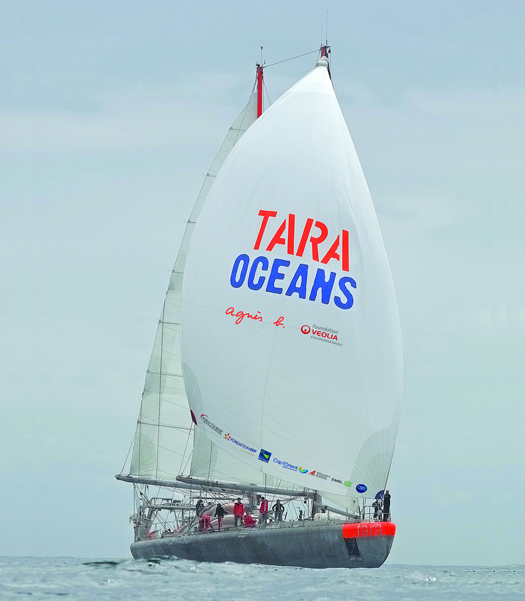
Dún Laoghaire Rathdown County Council, together with UCD Science Dept, the French Embassy, Dún Laoghaire BRAND project, Dún Laoghaire Harbour Company and Comhairle Na N'Óg are also delighted to announce that as part of the celebrations, they have collaborated to host the Irish Premiére of Planet Ocean, directed by Yann Arthus-Bertrand and Michael Pitiot in partnership with OMEGA. The screening will take place on 12 July to an invited audience in County Hall, Dún Laoghaire but the film will also be open to the public on Saturday 14th July in the Lighthouse Cinema Dublin as part of UCD's science week. For information about tickets please visit www.ucdimaginescience.ie


























